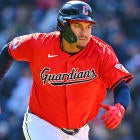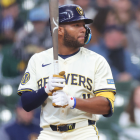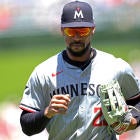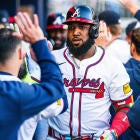Earlier this week, Dodgers ace Clayton Kershaw celebrated his 30th birthday. As is the case when anyone of note turns any age that's divisible by 10, this provides with us with an opportunity to assess what Kershaw has achieved and what may be ahead for him.
First -- breaking news not forthcoming -- Kershaw has been excellent. Across parts of 10 major-league seasons, he's worked 1,935 innings, pitched to a 2.36 ERA (161 ERA+), registered a K/BB ratio of 4.18, and struck out more than 2,000 batters. Along the way, Kershaw's won three Cy Young Awards and an MVP and made the All-Star Game seven times. Let's put a bit of that in context ...
- Kershaw is the active leader in ERA and also ranks 24th all-time.
- Kershaw is the active leader in park- and league-adjusted ERA (a.k.a., ERA+) and also ranks second all-time (behind Mariano Rivera, minimum 1,000 innings).
- Kershaw's 2,120 strikeouts rank 68th all-time.
Especially notable is how dominant Kershaw has been on a rate basis when it comes to preventing earned runs. As well, he's averaged fewer than five unearned runs allowed per season. Given a normal decline phase, he's going to wind up with one of the most impressive ERA/ERA+ marks of all-time.
In terms of total value, let's turn to Baseball-Reference's Wins Above Replacement (WAR) to see where Kershaw's body of work to date ranks since 1900. To the digits ...
| Pitcher | Total WAR through age-29 season |
|---|---|
Walter Johnson | 99.2 |
Chrisy Mathewson | 76.6 |
Roger Clemens | 62.8 |
Bert Blyleven | 59.6 |
Clayton Kershaw | 58.8 |
So, yes, Kershaw is very much keeping Hall of Fame company. As you can see, his WAR through age 29 ranks fifth all-time. He's just ahead of the impressive likes of Tom Seaver, Pedro Martinez, and Bob Feller. As such, it's no exaggeration to call the start to Kershaw's career one of the very best in MLB history.
So what's ahead? With pitchers, it's more about skill retention than age, and Kershaw's coming off a 2017 season in which he led the NL in ERA+ and K/BB ratio. As well, the CBS Fantasy projections tab him in 2018 for an ERA of 2.69 with 219 strikeouts in 184 1/3 innings. At some point, Kershaw will enter his decline phase -- now that he's 30, we can talk about that -- but he figures to continue pitching at an elite level, when healthy, for at least the next handful of seasons.
Speaking of "when healthy," that's been the issue for Kershaw. Over the last two seasons, he's averaged just 24 starts and 162 innings. That's not out of step with recent starting pitcher usage trends, but it's certainly out of step with Kershaw's pre-2016 history. Kershaw didn't go on the disabled list for the first time until 2014, when a shoulder strain laid him up. He bounced back from that to lead the majors in innings in 2015. Over the last two seasons, though, he's missed a combined three-and-a-half months with back problems. That's the kind of injury that tends to recur, and that's the big concern when it comes to Kershaw and our expectations for the back of half of his career.
So let's talk a bit about the back half of that career. To get a quick-and-dirty idea of how Kershaw's remaining career might play out, we'll turn to a Bill James concoction called the Favorite Toy. The Favorite Toy takes a player's age, career totals in a given stat, and recent performance history, runs it through a simple formula, and gives you a projected total for the category in question. For Kershaw, we'll project his WAR, wins (people still pay some attention to pitcher wins, so why not), and strikeouts. The results ...
- Kershaw is presently projected for 96 WAR, which would rank 11th on the all-time list since 1900 (just behind Blyleven and just ahead of Gaylord Perry and Warren Spahn). The Favorite Toy gives Kershaw a 42 percent chance of becoming just the eighth pitcher to reach 100 WAR.
- Kershaw enters the 2018 season with 144 career wins. He's projected to get to 245 with a 97 percent chance of reaching 200 wins. However, Kershaw has just a 15 percent chance of winning 300 games.
- As for strikeouts, he's presently forecast for 3,290, which would rank 12th all-time. The system gives him a 16 percent chance of reaching 4,000. Just four pitchers have pulled that off.
Barring something thoroughly unexpected, Kershaw's going to be a first-ballot Hall of Famer. If you look his current body of work, you could plausibly argue that he's on his way to being one of the five or so best pitchers in MLB history.
That's still entirely possible, but Kershaw's back problems have led to some downward trends when it comes to volume and durability. If those trends continue, then the second half of his career won't allow him to be in that discussion. If he's able to rediscover health, then he may well wind up mentioned in the same breath as Roger Clemens and Walter Johnson and Lefty Grove and the like (yes, we're all aware of Kershaw's postseason inconsistencies).
For Kershaw, the 2018 season will be a critical one. It could be his final season with the Dodgers (he has an opt-out in his contract), it could afford him another shot at World Series glory, and it could set the course for the remainder of his career. If he returns to healthy dominance (as opposed to "mere" dominance) in 2018, then the "greatest ever" watch will be back on.






















